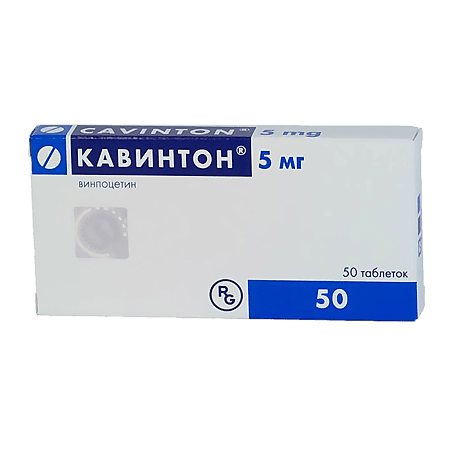No products in the cart.
Cavinton, tablets 5 mg 50 pcs
€4.73 €3.78
Description
A drug that improves cerebral blood circulation and brain metabolism.
Increases glucose and oxygen consumption by brain tissue.
Enhances neuronal resistance to hypoxia; by enhancing glucose transport to the brain through the BBB; shifts glucose breakdown to a more energy-efficient, aerobic pathway; selectively blocks Ca2+-dependent phosphodiesterase; increases brain AMP and cGMP levels. Increases ATP concentration in brain tissues; enhances brain noradrenaline and serotonin metabolism; stimulates ascending branch of noradrenergic system, has antioxidant effect.
Decreases platelet aggregation and increased blood viscosity; increases the deformability of red blood cells and blocks red blood cell utilization of adenosine; promotes oxygenation of red blood cells.
It enhances the neuroprotective effect of adenosine. Increases cerebral blood flow; decreases cerebral vascular resistance without significant changes in indicators of systemic circulation (BP, minute volume, HR, total peripheral resistance).
Not only does not have the effect of “stealing” but also increases the blood supply, especially in the ischemic areas of the brain with low perfusion.
Indications
Indications
Ophthalmology: chronic vascular diseases of the choroid and retina.
For the treatment of perceptual hearing loss, Meniere’s disease, idiopathic tinnitus.
Neurology: reducing the severity of neurological and mental symptoms in various forms of cerebral circulatory failure.
Pharmacological effect
Pharmacological effect
A drug that improves cerebral circulation and cerebral metabolism.
Increases the consumption of glucose and oxygen by brain tissue.
Increases the resistance of neurons to hypoxia; enhancing the transport of glucose to the brain through the BBB; transfers the process of glucose breakdown to an energy-efficient, aerobic path; selectively blocks Ca2+-dependent phosphodiesterase; increases levels of AMP and cGMP in the brain. Increases the concentration of ATP in brain tissue; enhances the exchange of norepinephrine and serotonin in the brain; stimulates the ascending branch of the noradrenergic system and has an antioxidant effect.
Reduces platelet aggregation and increased blood viscosity; increases the deforming ability of red blood cells and blocks the utilization of adenosine by red blood cells; helps increase oxygen delivery by red blood cells.
Strengthens the neuroprotective effect of adenosine. Increases cerebral blood flow; reduces cerebral vascular resistance without significantly changing systemic circulatory parameters (BP, minute volume, heart rate, general peripheral resistance).
Not only does it not have a “stealing” effect, but it also increases blood supply, primarily in ischemic areas of the brain with low perfusion.
Special instructions
Special instructions
Cavinton does not have hepato- and nephrotoxic effects, therefore, when prescribing the drug to patients with liver and kidney diseases, no dosage adjustment is required.
In case of lactose intolerance, please note that each tablet contains 83 mg of lactose.
Use in pediatrics
It is not recommended to prescribe the drug to children under 18 years of age due to the lack of experience in using Cavinton in this category of patients.
Active ingredient
Active ingredient
Vinpocetine
Composition
Composition
Active substance:
vinpocetine 5 mg.
Pregnancy
Pregnancy
Contraindicated during pregnancy. Vinpocetine penetrates the placental barrier.
Moreover, its concentration in the placenta and fetal blood is lower than in the blood of a pregnant woman.
At high doses, placental bleeding and spontaneous abortions are possible, probably as a result of increased placental blood supply.
Within an hour, 0.25% of the administered dose of the drug passes into breast milk.
When using the drug, you must stop breastfeeding.
Contraindications
Contraindications
acute phase of hemorrhagic stroke; severe form of ischemic heart disease; severe arrhythmias; pregnancy; lactation period; children under 18 years of age (due to insufficient data); lactose intolerance; hypersensitivity to vinpocetine.
Side Effects
Side Effects
Side effects associated with the use of the drug were rarely detected.
From the cardiovascular system: ECG changes (ST depression, prolongation of the QT interval); tachycardia, extrasystole, but the presence of a causal relationship has not been proven, because in natural populations these symptoms are observed with the same frequency; changes in blood pressure (usually a decrease), skin hyperemia, phlebitis.
From the central nervous system: sleep disturbances (insomnia, increased drowsiness), dizziness, headache, general weakness (these symptoms may be manifestations of the underlying disease).
From the digestive system: dry mouth, nausea, heartburn. Other: allergic skin reactions; increased sweating.
Interaction
Interaction
Not observed when used simultaneously with pindolol, clopamide, glibenclamide, digoxin, acenocoumarol and hydrochlorothiazide; imipramine.
In rare cases, simultaneous use with α-methyldopa is accompanied by a slight increase in the hypotensive effect; when using this combination, regular monitoring of blood pressure is necessary.
Despite the lack of data confirming the possibility of interaction, caution is recommended when coadministered with drugs with central, antiarrhythmic and anticoagulant action.
Overdose
Overdose
Currently, data on overdose of vinpocetine are limited.
Treatment: gastric lavage, taking activated carbon, symptomatic therapy.
Storage conditions
Storage conditions
The drug should be stored in a place protected from light, out of reach of children, at a temperature of 15° to 30°C.
Shelf life
Shelf life
5 years.
Manufacturer
Manufacturer
Gedeon Richter-RUS, Hungary
Additional information
| Shelf life | 5 years. |
|---|---|
| Conditions of storage | The drug should be stored in the dark place out of the reach of children at 15° to 30°C. |
| Manufacturer | Gedeon Richter, Hungary |
| Medication form | pills |
| Brand | Gedeon Richter |
Related products
Buy Cavinton, tablets 5 mg 50 pcs with delivery to USA, UK, Europe and over 120 other countries.














